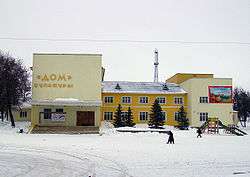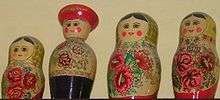Semyonov, Nizhny Novgorod Oblast
| Semyonov (English) Семёнов (Russian) | |
|---|---|
| - Town - | |
 House of Culture in Semyonov | |
.svg.png) Location of Nizhny Novgorod Oblast in Russia | |
.svg.png) Semyonov | |
|
| |
| Administrative status (as of May 2015) | |
| Country | Russia |
| Federal subject | Nizhny Novgorod Oblast[1] |
| Administratively subordinated to | town of oblast significance of Semyonov[1] |
| Administrative center of | town of oblast significance of Semyonov[1] |
| Municipal status (as of December 2012) | |
| Urban okrug | Semyonovsky Urban Okrug[2] |
| Administrative center of | Semyonovsky Urban Okrug[2] |
| Statistics | |
| Population (2010 Census) | 24,473 inhabitants[3] |
| Time zone | MSK (UTC+03:00)[4] |
| First mentioned | 1644 |
| Town status since | 1779 |
| Postal code(s)[5] | 606650–606654, 606667, 606669 |
|
| |
| Semyonov on Wikimedia Commons | |
| 2010 Census | 24,473[3] |
|---|---|
| 2002 Census | 25,298[6] |
| 1989 Census | 26,282[7] |
| 1979 Census | 25,199[8] |
Semyonov (Russian: Семёнов) is a town in Nizhny Novgorod Oblast, Russia, notable for being a major center for traditional handcrafts such as Khokhloma wood painting and matryoshka dolls. As of the 2010 Census, its population was 24,473.[3]
Geography
The town is situated in an area of lowland bogs and forests, about 100 kilometers (62 mi) northeast of Nizhny Novgorod, the administrative center of the oblast. The Kerzhenets River flows through the town. The surrounding area includes most of the Kerzhenets Nature Reserve, a federal-level strict ecological reserve, established for the protection and scientific study of the local ecology of the region.
History

It was established in the beginning of the 17th century as a settlement of Old Believers. According to an Old Believer legend, the Old Believer settlement in the area was spurred by the existence of the ancient Olenevsky Skete (today, the village of Bolshoye Olenevo, some 24 kilometers (15 mi) southeast from Semyonov), which had supposedly been founded in the 15th century by some of Venerable Macarius's monks to commemorate their leader's Miracle of the Moose that took place at that site, and later joined the Raskol.[9]
The first documented mention of Semyonov was in 1644; it was referred to as Semyonov's hamlet, later as Semyonovo village, and from 1779 as the uyezd town of Semyonov.
From the beginning of the 19th to the early 20th century, it was a center for Old Believers movement and the only place to produce Old Believers' religious items such as lestovka prayer beads.
Administrative and municipal status
Within the framework of administrative divisions, it is, together with 1 work settlement and 190 rural localities, incorporated as the town of oblast significance of Semyonov—an administrative unit with the status equal to that of the districts.[1] As a municipal division, the town of oblast significance of Semyonov is incorporated as Semyonovsky Urban Okrug.[2]
Economy and crafts

Since 1918 Khokhloma wood painting became a major craft in Semyonov. In 1960, Semyonov was organized as a factory named Khokhlomskaya rospis ("Хохломская роспись", Russian for "Khokhloma painting").
This factory specialized in the production of hand-painted wooden items (ranging from tableware to toys and furniture) with unique style, and also matryoshka dolls, marketed as souvenir items.[10] The factory offers tours around the various stages of production and visitors can see craftspeople making and painting the items in traditional Russian styles.
Transportation
Semyonov is located on the Nizhny Novgorod-Kotelnich railway, which is part of one of the main routes used by trains traveling from Moscow to the Urals and Siberia. The town is served by electric commuter trains, connecting it to Nizhny Novgorod in just over an hour.
References
Notes
- 1 2 3 4 Law #184-Z
- 1 2 3 Law #211-Z
- 1 2 3 Russian Federal State Statistics Service (2011). "Всероссийская перепись населения 2010 года. Том 1" [2010 All-Russian Population Census, vol. 1]. Всероссийская перепись населения 2010 года (2010 All-Russia Population Census) (in Russian). Federal State Statistics Service. Retrieved June 29, 2012.
- ↑ Правительство Российской Федерации. Федеральный закон №107-ФЗ от 3 июня 2011 г. «Об исчислении времени», в ред. Федерального закона №271-ФЗ от 03 июля 2016 г. «О внесении изменений в Федеральный закон "Об исчислении времени"». Вступил в силу по истечении шестидесяти дней после дня официального опубликования (6 августа 2011 г.). Опубликован: "Российская газета", №120, 6 июня 2011 г. (Government of the Russian Federation. Federal Law #107-FZ of June 31, 2011 On Calculating Time, as amended by the Federal Law #271-FZ of July 03, 2016 On Amending Federal Law "On Calculating Time". Effective as of after sixty days following the day of the official publication.).
- ↑ Почта России. Информационно-вычислительный центр ОАСУ РПО. (Russian Post). Поиск объектов почтовой связи (Postal Objects Search) (Russian)
- ↑ Russian Federal State Statistics Service (May 21, 2004). "Численность населения России, субъектов Российской Федерации в составе федеральных округов, районов, городских поселений, сельских населённых пунктов – районных центров и сельских населённых пунктов с населением 3 тысячи и более человек" [Population of Russia, Its Federal Districts, Federal Subjects, Districts, Urban Localities, Rural Localities—Administrative Centers, and Rural Localities with Population of Over 3,000] (XLS). Всероссийская перепись населения 2002 года [All-Russia Population Census of 2002] (in Russian). Retrieved August 9, 2014.
- ↑ Demoscope Weekly (1989). "Всесоюзная перепись населения 1989 г. Численность наличного населения союзных и автономных республик, автономных областей и округов, краёв, областей, районов, городских поселений и сёл-райцентров" [All Union Population Census of 1989: Present Population of Union and Autonomous Republics, Autonomous Oblasts and Okrugs, Krais, Oblasts, Districts, Urban Settlements, and Villages Serving as District Administrative Centers]. Всесоюзная перепись населения 1989 года [All-Union Population Census of 1989] (in Russian). Институт демографии Национального исследовательского университета: Высшая школа экономики [Institute of Demography at the National Research University: Higher School of Economics]. Retrieved August 9, 2014.
- ↑ "Всесоюзная перепись населения 1979 г. Национальный состав населения по регионам России. (All Union Population Census of 1979. Ethnic composition of the population by regions of Russia.)". Всесоюзная перепись населения 1979 года (All-Union Population Census of 1979) (in Russian). Demoscope Weekly (website of the Institute of Demographics of the State University—Higher School of Economics. 1979. Retrieved 2008-11-25.
- ↑ Оленевский скит (Olenevsky Skete) (Russian)
- ↑ "The hardworking women behind the matryoshkas hope for an Olympic boost". July 18, 2011, Natalya Radulova, Ogonyok
Sources
- Законодательное собрание Нижегородской области. Закон №184-З от 16 ноября 2005 г. «Об административно-территориальном устройстве Нижегородской области», в ред. Закона №67-З от 13 мая 2015 г «Об изменении административно-территориального деления Чкаловского района Нижегородской области и о внесении изменения в статью 11 Закона Нижегородской области "Об административно-территориальном устройстве Нижегородской области"». Вступил в силу по истечении десяти дней со дня официального опубликования. Опубликован: "Нижегородские новости", №218(3390), 23 ноября 2005 г. (Legislative Assembly of Nizhny Novgorod Oblast. Law #184-Z of November 16, 2005 On the Administrative-Territorial Structure of Nizhny Novgorod Oblast, as amended by the Law #67-Z of May 13, 2015 On Changing the Administrative-Territorial Structure of Chkalovsky District of Nizhny Novgorod Oblast and on Amending Article 11 of the Law of Nizhny Novgorod Oblast "On the Administrative-Territorial Structure of Nizhny Novgorod Oblast". Effective as of after ten days from the day of the official publication.).
- Законодательное Собрание Нижегородской области. Закон №211-З от 22 декабря 2010 г. «О преобразовании муниципальных образований Семёновского муниципального района Нижегородской области», в ред. Закона №150-З от 7 декабря 2012 г. «Об изменении границ административно-территориальных образований – Беласовский сельсовет, рабочий посёлок Сухобезводное, Шалдежский сельсовет административно-территориального образования город областного значения Семёнов Нижегородской области и о внесении изменений в отдельные Законы Нижегородской области». Вступил в силу по истечении десяти дней со дня официального опубликования. Опубликован: "Нижегородские новости", №234(4606), 23 декабря 2010 г. (Legislative Assembly of Nizhny Novgorod Oblast. Law #211-Z of December 22, 2010 On Transforming the Municipal Formations of Semyonovsky Municipal District of Nizhny Novgorod Oblast, as amended by the Law #150-Z of December 7, 2012 On Changing the Borders of the Administrative-Territorial Formations of Belasovsky Selsoviet, the Work Settlement of Sukhobezvodnoye, Shaldezhsky Selsoviet of the Administrative-Territorial Formation of the Town of Oblast Significance of Semyonov of Nizhny Novgorod Oblast and on Amending Various Laws of Nizhny Novgorod Oblast. Effective as of the day which is after ten days from the day of the official publication.).
External links
- Official website of Semyonovsky Urban Okrug (Russian)
- Mojgorod.ru. Entry on Semyonov (Russian)